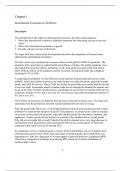Chapter 1
International Economics Is Different
Overview
The introduction to the subject of international economics has three major purposes:
1. Show that international economics addresses important and interesting current events and
issues.
2. Show why international economics is special.
3. Provide a broad overview of the book.
We begin with four controversial developments that show the importance of current issues
addressed by international economics.
The first controversy examines the economic effects of the global COVID-19 pandemic. The
pandemic led to great harm to global health and millions of deaths. The global pandemic crisis
also had global economic effects, including a swift, deep global recession in the first half of
2020. With the effects of the pandemic and the recession, international trade also collapsed,
declining by 8% in 2020.
A surprising development was the difference in the declines of good trade and services trade
globally. In previous global recessions, the trade decline was large for goods, especially durable
goods, and small for services. But in 2020, the decline in good trade was smaller than the decline
in services trade. Economists usually examine trade drivers through the demand for imports and
focus on the roles of relative product prices and changes in real income. For goods, these drivers
predicted a decline of 10%, but it was only 6%. For services, these drivers predicted a decline of
8%, but it was 25%.
The COVID-19 recession was different from previous recessions in many ways. Two help us to
understand why the predictions from the standard demand drivers were so wrong.
Why did goods trade fall by less, even though lockdowns limited goods production and created
problems for international transport of goods? The pandemic recession led to a shift in demand,
away from services and toward goods, especially durable goods like electronics, furniture, and
appliances. Trade in goods did not decline by as much as the standard drivers would predict.
Why did services trade fall so much? Much of the shift in demand was a very large decrease in
international travel and tourism, which declined by 80% in the second quarter of 2020 and
remained at that much lower level through 2021.
In a pandemic, access to medical goods is crucial. In the United States, access to imports from
China became controversial. Of the four main types of medical goods, the United States was
dependent on China for a large part of its total supply of personal protective equipment (PPE).
China has a comparative advantage in producing PPE, based on its relative abundance of
medium-skill workers.
2
, How did the United States end up short of PPE as the pandemic hit in March 2020? First, the
pandemic had hit China in January, and Chinese exports fell off as demand within China
increased. Second, U.S. stockpiles of PPE were low, in part because U.S. tariffs imposed on
imports from China in 2019 reduced U.S. buying.
With strong U.S. demand and limited supply, prices rose dramatically. That incentivized
additional supply. For U.S. production, the U.S. government added subsidies to the incentives.
But, increased U.S. production was not enough. The higher prices also incentivized Chinese and
other foreign export producers, and U.S. imports increased. By early to mid-2021, the global
shortage of PPE was resolved.
Concerns about the availability of imports spread to other goods, especially those produced
through sometimes complex global supply chains (GSCs). At their core, GSCs are also based on
comparative advantage. To lower the cost of producing a final product, site each production step
in its lowest cost location. The COVID-19 pandemic exposed GSCs to a range of risks including
lockdowns and restrictions that cut access to components. How could production of the final
products be made more resilient? Should all or most of the production steps be brought back
(“reshored”) to a firm’s main country? Each business manages its supply chain risks, and most
GSCs turned out to be more resilient than many initially feared. (An exception was automobiles,
because the auto firms could not regain their access to enough semiconductors.) Reshoring
sounds like a way to reduce risk, but it would actually concentrate risks in a single country. And,
in eliminating international trade within the GSC, the gains from trade (discussed in Chapters 2–
6) would be lost.
The economic effects of the global COVID-19 pandemic crisis appear throughout the rest of the
book:
• The trade collapse (Chapter 2)
• Export restrictions on PPE and other goods (Chapter 8)
• The decline and rebound of migrant remittances (Chapter 15)
• The increases in the U.S. trade and current account deficits (Chapter 16)
• Financial disruptions and increased deviations from covered interest parity (Chapter
18)
• A large new allocation of SDRs and expanded emergency lending by the IMF
(Chapters 20 and 21)
• U.S. inflation rates first declined then went much higher (Chapter 22)
• The U.S. fiscal response and the effects on private saving and government dissaving
(Chapter 24)
• Investors’ “dash for cash” in March 2020 and the expansion of central bank liquidity
swaps (Chapter 24)
• The EU suspension of national fiscal policy rules and its first large unionwide fiscal
policy (Chapter 25)
The second controversy arises from international migration, especially the increasingly vehement
complaints about immigrants in many of the major receiving countries. In these countries, a
rather large (10% or more) and rising percentage of the population is foreign-born, including
many who are undocumented. Opponents accuse immigrants of causing general economic harm,
3




